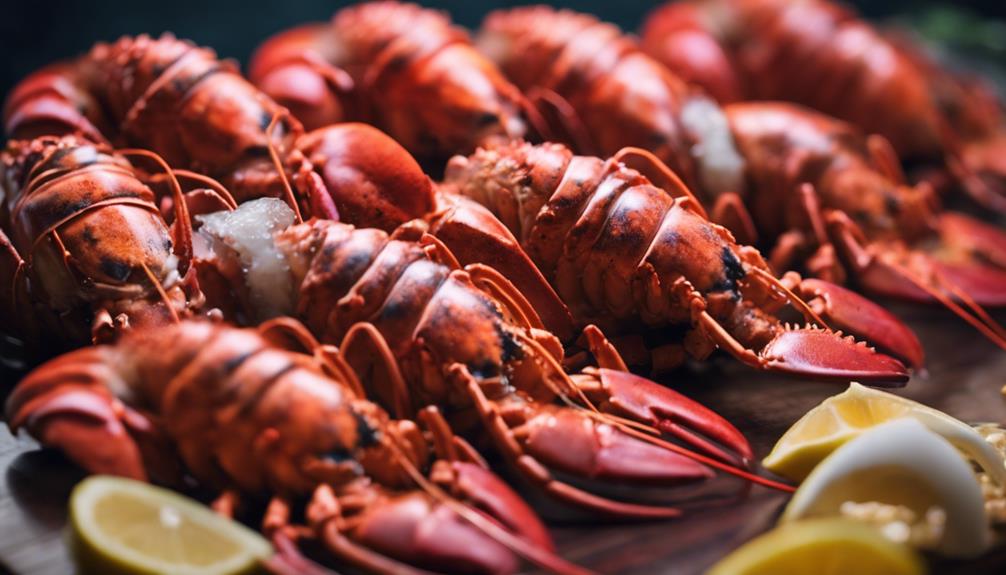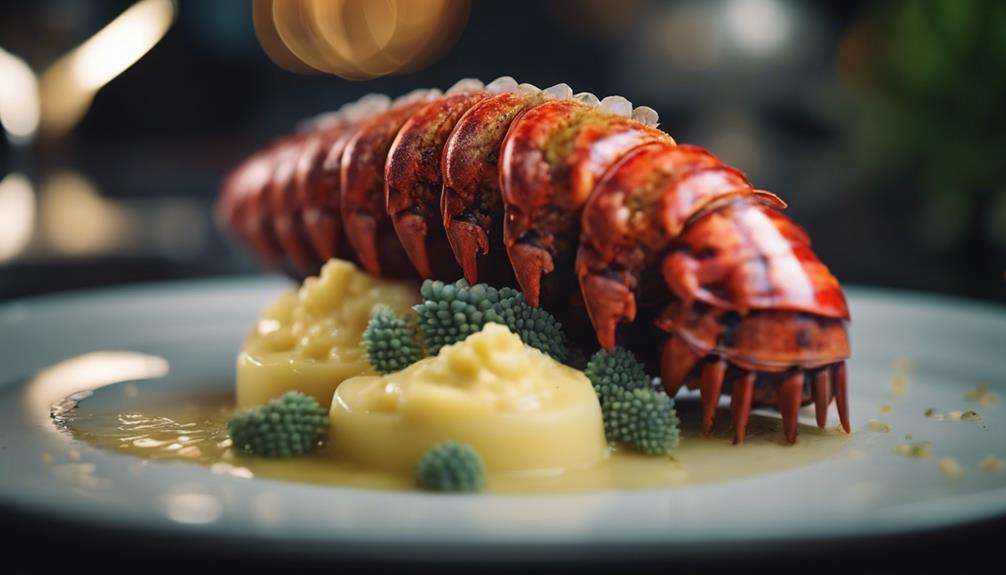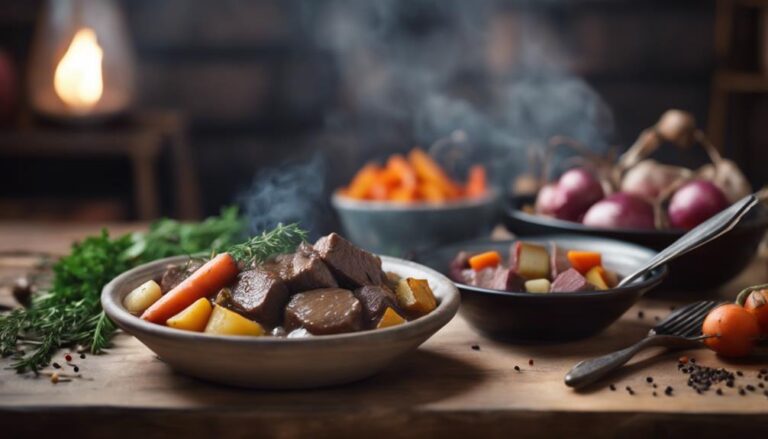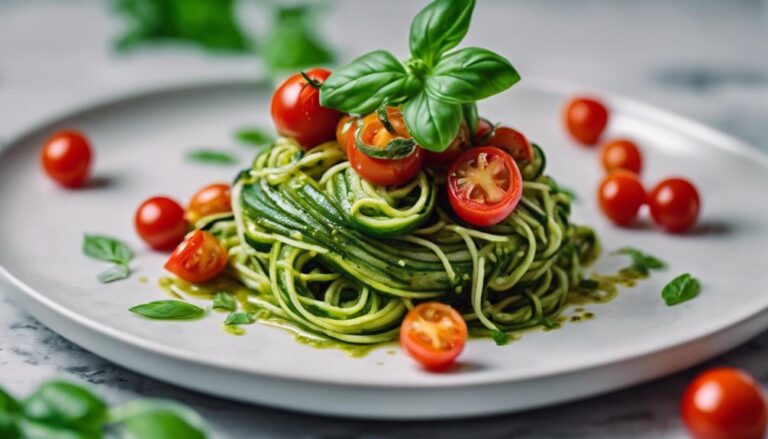Sous Vide Garlic Butter Lobster Tails
Immerse lobster tails in garlic butter, seal in bag, and sous vide for buttery perfection. Enhance flavor with herbs, garlic, and truffle salt. Experiment with cooking temperatures for personalized tenderness. Elevate the dish to a refined delicacy.
What You Will Learn Here
- Sous vide method ensures tender, buttery lobster tails.
- Infuse garlic butter for enhanced flavor profile.
- Utilize herbs, citrus zest, or truffle salt for depth.
- Experiment with temperatures for personalized results.
- Elevate dish with culinary finesse and luxury elements.
Origin of Lobster Consumption

Long before lobster became a symbol of luxury dining, it was a humble fare for the common man.
The evolution from being a low-cost source of sustenance to a gourmet delight reflects changes in societal perceptions and advancements in transportation.
Understanding the journey of lobster consumption sheds light on its significance in culinary history.
Lobster as Delicacy
Lobster, a delicacy savored for centuries, holds a rich history of consumption dating back to Native American and early European settlers. Initially deemed a low-class meal, lobster was served to prisoners and servants. However, in the mid-19th century, it underwent a transformation into a symbol of luxury, particularly in North America.
At one point, lobsters were so plentiful that they were used as fertilizer and animal feed. Nowadays, lobster is revered as a premium seafood delicacy, featured in diverse culinary creations worldwide. Its succulent meat and rich flavor make it a sought-after ingredient for those craving a taste of indulgence and sophistication.
Enjoy the culinary journey of lobster, a luxurious delight fit for the most discerning palates.
Lobster Harvesting Practices
Originating in the 1600s in North America, the harvesting practices of lobsters reflect a historical shift from humble fare to a symbol of culinary refinement and luxury.
Sustainable lobster harvesting practices, such as size regulations, trap limits, and seasonal closures, are essential for maintaining lobster populations. In the Maine fishing industry, strict regulations are followed to guarantee the long-term health and sustainability of lobster populations. Size regulations help protect juvenile lobsters, allowing them to grow and reproduce before being caught.
Trap limits prevent overfishing, giving lobsters a chance to replenish their numbers. Seasonal closures during the breeding season help safeguard the future of lobster populations. By adhering to these practices, the Maine fishing industry plays a crucial role in preserving the lobster population for future generations.
Lobster Culinary Versatility
Having evolved from a modest staple to a symbol of culinary sophistication and luxury, lobster's journey through culinary history reflects a remarkable transformation. Native Americans were among the first to include lobster in their diets, long before it gained popularity in European cuisine.
Once viewed as a humble food source, lobster's status shifted over time to become a sought-after delicacy due to its rich flavor and delicate texture. The versatility of lobster meat allows for a myriad of culinary creations, from decadent butter-poached lobster tails to delicate lobster bisque.
In modern kitchens, techniques like sous vide cooking using an immersion circulator and vacuum seal bags have elevated lobster dishes to new heights, such as the exquisite Sous Vide Garlic Butter Lobster Tails.
Lobster Tail Varieties

For the ultimate dining experience, selecting the right variety of lobster tails is essential to elevate the flavors in your dish. When it comes to lobster tail varieties, there are important factors to take into account to guarantee a delectable meal:
- Cold Water Lobster Tails: Preferred for their cleaner, sweeter flavor profile, cold water lobster tails are a popular choice among chefs looking to enhance the taste of their dishes.
- Warm Water Lobster Tails: Be cautious when opting for warm water lobster tails as they may contain injected chemicals that can alter the taste and texture of the meat.
- Fresh or Flash-Frozen Cold Water Tails: Ideal for sous vide cooking, fresh or flash-frozen cold water tails retain their quality and flavor, making them a top choice for those seeking perfection in their dishes.
Sous Vide Lobster Tail Varieties
When selecting lobster tails for sous vide cooking, opting for cold water varieties is key. Their cleaner, sweeter taste profile sets them apart from warm water options that may have added chemicals.
Ensuring quality and flavor in your dish starts with choosing the right lobster tail variety for your sous vide experience.
Butter-Poached Lobster Tail Method
To master the art of butter-poached lobster tails using the sous vide method, precision in temperature control is crucial for achieving the ultimate tenderness and flavor infusion. When preparing butter-poached lobster tails, follow these essential steps:
- Seal the lobster tails in a vacuum bag with a generous amount of garlic-infused butter.
- Set the sous vide water bath to the precise temperature recommended for lobster tails, typically around 140°F (60°C).
- Allow the lobster tails to cook in the buttery bath for the specified time to make sure they reach the perfect succulent texture.
Velvety Lobster Tail Delight
Mastering the art of sous vide cooking opens up a world of possibilities for creating velvety lobster tail delights that elevate your culinary skills to new heights. When it comes to preparing Sous Vide Garlic Butter Lobster Tails, the key lies in the meticulous control of temperature and the infusion of rich garlic butter flavors. Here are three essential points to ponder when crafting this gourmet dish:
- Precise Temperature Management: Sous vide guarantees that the lobster tails are cooked to perfection, resulting in a tender and succulent texture.
- Rich Garlic Butter Infusion: The recipe calls for infusing the lobster tails with a decadent garlic butter mixture, enhancing the natural sweetness of the lobster meat.
- Gourmet Experience: Indulge in a luxurious dining experience by savoring these velvety lobster tails, a gourmet delight that can be easily recreated at home for special occasions.
Velvety Lobster Tail Indulgence
Indulge in the exquisite variety of sous vide lobster tails, each offering a velvety texture and rich flavor profile that elevates your dining experience to new heights.
When it comes to sous vide lobster tails, the infusion of garlic butter takes this luxurious dining experience to the next level.
The precise cooking method of sous vide guarantees that every bite is perfectly tender, making it a restaurant-quality dish that you can enjoy in the comfort of your home.
The marriage of garlic butter with the delicate lobster meat not only adds a touch of richness but also enhances the seafood's natural flavors, creating a decadent and unforgettable meal.
Sous Vide Lobster Tail Temps
When cooking sous vide lobster tails, the ideal temperature of 135°F is recommended for a tender and buttery texture.
However, opting for 130°F will result in a slightly softer consistency, while 140°F will yield a firmer texture.
Experimenting with these temperatures allows you to tailor the lobster tails to your desired level of doneness.
Ideal Cooking Temperatures
To achieve the desired texture and doneness when cooking sous vide lobster tails, it's important to meticulously control the water temperature within the range of 130°F to 140°F. This precise cooking guarantees that the lobster tails are cooked to perfection.
Cooking at 130°F results in a delicate texture, while selecting 140°F yields a firmer bite. By experimenting with different temperatures within this range, you can customize the texture of the lobster meat to suit your preferences.
Sous vide cooking guarantees even cooking throughout the lobster tails, preserving their natural flavors and juices. Remember, maintaining the ideal temperature is crucial to achieving a mouthwatering sous vide lobster tail experience.
Cooking Time Guidelines
For succulent and perfectly cooked lobster tails using the sous vide method, stick to the recommended cooking times at specific temperatures. Set your sous vide water bath to 135°F and cook the lobster tails for 45 minutes.
This precise cooking time and temperature combination guarantees that the lobster meat is tender and buttery, delivering a delightful dining experience. The sous vide method assures consistent texture and flavor throughout the lobster tails, eliminating the risk of overcooking or undercooking.
Experimenting with different temperatures like 130°F or 140°F allows you to personalize the results to your liking. Achieving perfect doneness is effortless with sous vide, and infusing the lobster tails with garlic butter during cooking enhances their flavor profile, creating a truly indulgent dish.
Flavor Infusion Options
Enhance the succulent taste of sous vide lobster tails by infusing them with a variety of flavorful options like herbs, garlic, shallots, citrus zest, and black truffle salt. Different temperatures ranging from 130°F to 140°F can be utilized for flavor infusion, allowing you to tailor the cooking process to your desired level of doneness and taste intensity.
Garlic and shallots are excellent choices for adding depth and aroma to the lobster tails, while the invigorating brightness of citrus zest can provide a contrasting flavor. For a touch of luxury, consider sprinkling some black truffle salt before sealing the lobster tails for sous vide cooking.
Experimenting with these flavor infusion options will allow you to create a truly exquisite dining experience with your sous vide lobster tails.
Final Thoughts
In reflecting on the indulgent experience of savoring sous vide garlic butter lobster tails, one can't help but appreciate the harmonious blend of flavors and the culinary finesse that elevates this dish to a level of sophistication. The marriage of garlic butter with succulent lobster tails creates a symphony of taste that's both luxurious and flavorful. The precise cooking method of sous vide guarantees that each bite is a perfect balance of tenderness and juiciness, showcasing the quality of the ingredients at its best.
The infusion of garlic and butter not only adds richness but also complements the natural sweetness of the lobster meat, resulting in a delightful gastronomic journey for your palate. Whether you're planning a romantic dinner or hosting a special occasion, these garlic butter lobster tails are sure to impress with minimal effort, making them a go-to recipe for moments that call for something extraordinary. Embrace the simplicity and elegance of this dish, and treat yourself and your guests to a culinary experience that's truly unforgettable.
Frequently Asked Questions
How Long Does It Take to Sous Vide a Lobster Tail?
When sous vide timing lobster tails, achieving perfect texture hinges on precision cooking. Follow sous vide tips diligently for best results. Longer cooking times infuse more flavor and render tender, buttery meat. Maintain steady water temperature for success.
Can You Overcook Lobster in Sous Vide?
You can definitely overcook lobster in sous vide. Lobster texture suffers when timing precision is off. Sous vide techniques excel in maintaining temperature control. Be vigilant to avoid mushiness. Correct timing guarantees succulent results.
What Is the Most Tender Way to Cook Lobster Tail?
For the most tender lobster texture, consider sous vide cooking. This method provides precise temperature control, preserving the delicate meat. It guarantees consistent results, infuses flavor profiles, and pairs well with various seafood options.
How Does Gordon Ramsay Cook Lobster Tail?
To cook lobster tails like Gordon Ramsay, use precise techniques for tender results. Equip your kitchen with essential tools. Pair fresh ingredients with flavorful combinations. Present with finesse. Get tips, explore variations, and elevate your dish.
Conclusion
Indulge in the succulent flavors of sous vide garlic butter lobster tails for a luxurious dining experience. The tender meat infused with savory garlic butter will melt in your mouth, leaving you craving more.
Elevate your cooking skills with this simple yet elegant dish that's sure to impress your guests. Treat yourself to a taste of decadence with every bite of these perfectly cooked lobster tails. Bon appétit!











